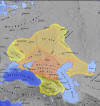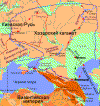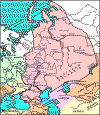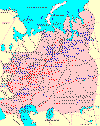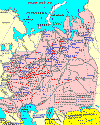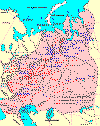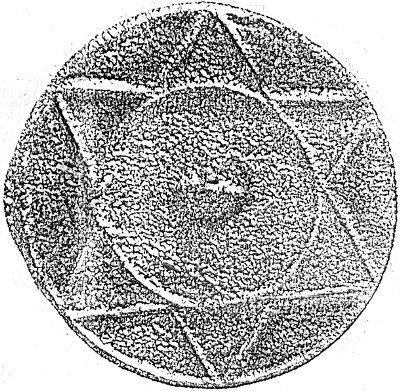70
§2. Khazar coins of the 8th - 9th cc.
In the Itil and Urals territories, bronze ingots
and Sasanid coins were replaced with Byzantine and especially Arab
coins. The Byzantine coins are found in the Eastern Europe almost everywhere. But the spread of the earliest
Byzantine coins (5 - 7 cc.) falls on the territory of the Khazar Kaganate, and apparently is
connected with the emergence of the Khazar cities and development of the monetary trade relations and feudal
relations. Individual finds of the Byzantine gold coins - solidi of the 6th - 7th cc. were recorded
in the Northern Caucasus, Itil region, Don region, and in the Middle and Lower Dnieper region 1.
To establish the exact time of emerging the Khazar state is difficult. However, it is known that in the
second half of the 5th c., after the break-up of the Hun Empire, during the the time of the Attila's sons, in western
part had gradually risen
the Avars, and after the name of the strongest tribe the state became known as Avar Kaganate. In the east of the Hun
state went on the same struggle for power. Still during Attila time, his youngest
(Ernach, Ernakh, Ernac, Ernas, Ernich, Hernak, Irnik, Ellak, Csaba, Chaba) son was sent
as a viceroy to the
east to the Khazars. But the formation of the Khazar state, which besides the Khazars included Bulgars,
Iskily, Barsils, Suvars, and other tribes, happened not before the 7th
c., i.e.
after the collapse of the Türkic Kaganate.
The flow to the Itil and Urals territories of the Byzantine silver hexagrams is associated with the name of Emperor
Heraclius (610-641). In 615 Heraclius, along with minting of solidi, launched a new
denomination, double milliarisies or hexagrams.
In the S.Caucasus were found many hoard and individual hexagrams. They are also known in
the North Caucasus. In the Eastern Europe, a small number of known hoards of these coins were found in North
Pontic (Kubrat's/Kurbat's treasury), and in the Itil and Urals territories (Bartym, Shestakovo).
Around 1950 near a village Bartym was found a large silver cup with 264 Heraclius' coins. The
Shestakovo hoard, together with the Byzantine hexagrams, also had Sassanid drachmas of the 5th - 6th cc.
Interestingly, the Bartym hoard coins are of the same type, i.e. they were never in circulation,
and were taken directly from the imperial mint. It is known that in 611 Persians invaded Syria, and
in 614 captured Jerusalem and Egypt. Heraclius managed to withstand the onslaught of the Persians
using Khazars. Thus, the appearance of one type coins is not surprising. However, as we have
learned, the demand for the coins in the Itil and Ural regions existed long before the Byzantine
coins. This is also evidenced by the Shestakovo hoard, where along with Byzantine coins were also
were the earlier Sasanid drachmas.
That the Heraclius' hexagram are found, in addition to the Northern Caucasus, in the Itil and Urals territories,
is apparently associated
with the the Khazars' activities. However, circulation of the coins as means of payment
in the 7th c. undoubtedly went on in the North Caucasus, where were the earlier political centers of the Khazars.
Since cities were major hubs in the coin circulation, we will address them (one of the Khazar earliest capital cities was Belenjer
in the N. Caucasus, it is the Upper Chirut fortress in the Terek- Sulak
interfluve) 2.
1 Kropotkin V.V. Economic relations of the Eastern Europe in the 1st millennium,
Moscow, 1967, p. 47
2 Magomedov M.G. Formation of the Khazar Kaganate, Moscow, 1983, p. 49.
71
The city was quite large (16,000 m 2) and fortified with powerful, reaching 10 m in width
2-shell walls with regularly spaced towers.3 A second Khazar major political center
was
Semender, located, according to M.G. Magomedov, south of the ancient Belenjer.
Neither Belenjer (Balanjar), nor
Semender (Samandar) were Khazar cities. Belenjer was a capital of Kayi Hun refugees after their
first capital Varachan, the “Old” Belenjer, aka “Khamzin”, was decimated by the Arabs in 739 during
the 737 Marwan's campaign. With the accent of the Suvar Huns, Varachan was a seat of the Suvar
ruler. Varachan was retaken by the Khazar army in 762. The Suvar Huns' capital was relocated from
Varachan to
Semender after the capture of Varachan. The Hun ruler was an independent ally of the Khazars, but in
the Arabic historiography the ethnic names of Masguts, Kayi, and Huns are covered by the umbrella
politonym “Khazar”. Semender was also temporarily abandoned in 739 during the 737 Marwan's
campaign. Semender is the present Makhachkala in the Caspian littoral. During the war, Semender was
a field command center of the Khazar army.
|
Conceptual location of individual domains |
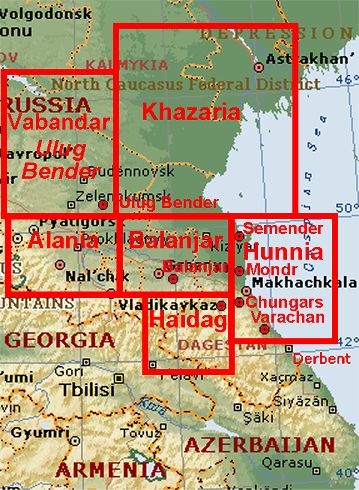 |
| Map ca. 1900, red dots show tentative locations of
Varachan |
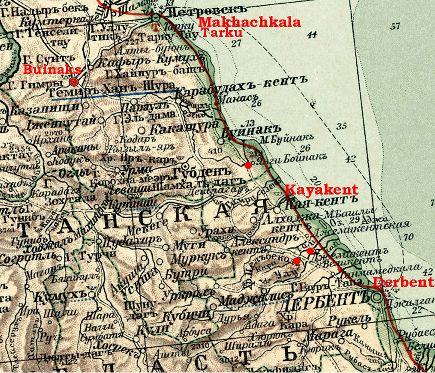 |
It is obvious that the name Kayakent is a form of Kayikent
(42.38°N 47.9°E, 45 km north of Derbent), which not only reflects the original Kayi owners of the
city, but still is populated by the Türkic “Kumyks”, at least some fraction of whom can draw their
descent from the original founders of the city, the Kayi Huns, and the site should be a first
contender for the location of the Kayi city Varachan |
|
Infiltration of numerous coins in these areas was not caused as a result of the Khazars',
Bulgars', or Suvars' military actions, but because of the close trade and friendly contacts with the Byzantine Empire,
which helped Khazars resist the invading Persians and Arabs. That many Byzantine
coins, the gold solidus and silver hexagrams, reached Khazaria as a result of trade and of the
Byzantine emperor rewarding the Khazar, Suvar, etc. leaders, is attested by written sources such hoards as
the Bartym hoard. But later, with the growth of cities and the development of the monetary trade
relations, the
demand for coins as a medium of exchange becomes permanent, and it became
necessary to meet the demand by establishing Khazar own coinage.
The emergence of Khazar coinage.
The phenomenon of Khazar coinage-imitation of the Arab dirham is studied well enough
4. But no
less important appears to be the beginning of Khazar coinage-of the Byzantine coinage. Notably, in the Khazar
necropolis in Belenjer, investigated by M.G.Magomedov, were found not only gold coins
of the Mauritius Tiberius (582-602), Heraclius (613-616), and his son Heraclius Constantine (613-641), but also the local gold
minting, or rather one-side castings, the imitation of the Heraclius and
Heraclius Constantine solidus (Fig. 20)5.
| Fig. 20. Khazar imitation of Heraclius' solidus |
|---|
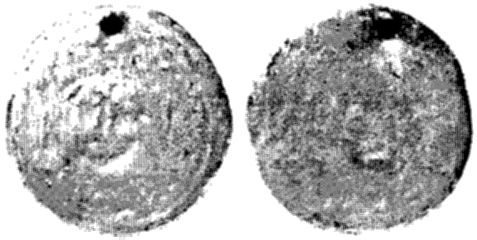 |
| The Khazar attribution of the imitation coin asynchronous and is valid only within the the scope of the history
of the Khazar mints. At the time of the imitation coins, Belenjer was a city of the Caucasian Huns
under nominal jurisdiction of the Türkic Kaganate and its Caucasus viceroy known as Alp Ilitver, the
Elteber Bahadyr Chebe, a grandson of Tun-Yabgu Kagan who appears in the Armenian chronicles as Alp
Ilitver. In the few decades following the death of Heraclius (610-641), neither Alp Ilitver nor the
Caucasus Huns can be identified with the Khazars. The Khazars just have not been there. Not yet. A
century later, only after the Arab assault in 737, the devastated Hunnic state fell under protection
of the Khazar Empire. Thus, the imitation is an artifact of the Kayi Huns minting. That is
consistent with the dynastic status of the Kayi tribe. |
Like any Middle Ages country, a very large and permanent source of income for the
Khazar Kagan were taxes and tribute from the Kaganate population, and from some dependent
tribes. The Northern Caucasus tribes, population of Crimea, Eastern Europe, including some
most developed eastern Slavic tribes, paid a “chimney” tribute. According to archaeological
data, as early as in the late 7th c. (ca 690), near the Khazar
forts along the northern Donets
appear the Slavic settlements of the Penkov type 6 (Prague- Penkov type).
| Praha-Penkov culture (presumably Slavic) - non-kurgan non-urn no-inventory cremation
burials, sometimes with ashes in Penkov-type pot urns, sometimes urns with covers, buried in pits
0,3-0,5 m deep. Dating is from 6th c. AD. Frequently, ethnically mixed burials with inhumations, at
times inhumations with Tengrian-type provisions for travel. The “northern Donets” should not be confused with the Seversky Donets (in Slavic “north” is “sever”). The Seversky Donets is named after
the Türkic Suvar tribe, in Slavic “Severyane”, which is homophonous with the Slavic term “severyane”
that is “northerners”. It is confusing now, but it made easier for the Slavic newcomers to master
the Türkic name. |
3 Magomedov M.G. Formation of the Khazar Kaganate, Moscow, 1983, p. 50.
4 Bykov A.A. From history of Khazaria money circulation in the 8th - 9th cc.//Eastern
sources on history of South-Eastern and Central Europe. - Vol. 3 - p. 26.
5 Magomedov M.G. Ibid, p. 86.
6 Pletneva S.A. Ethnical heterogeneity of the population of northwestern Khazar borderlands//New in
archeology, Moscow, 1972, p. 108.
72
Of such tribute and its size are known records of Old Slavic chronicler from the time after the
Khazar state had fractured, And Kozari had from Alans (Polyane), and
Suvars (Severs), and Finns (Vyatiches),
had a white (winter) squirrel pelt (or white [coin]) and (summer) squirrel per chimney”
7. Collecting tribute, in
this case a silver coin a squirrel pelt were special tudun (OT “smoke”) officers
(Alt. tutun, Türkic and Chinese, recorded in Chinese chronicles). The term in the form
tiun was preserved in the Old Russian (Old Slavic) language.
(d to y transition is regular in the ancient Türkic).
It seems that searches for etymology of the names Belenjer and Semender in Persian, although in keeping with established traditions,
have no justification 8. Judging by
the affixes, their forms are almost identical with other later names of the Bulgar and Suvar cities that
sprang up in the Itil region, Bulgar and others, where it is difficult to see a Persian influence. However, some
distinction is noticeable. For example, the affixes in the names of these Khazar
cities instead of the y-ed vowel we see dj and d. Instead of Common Türkic yer - earth, city, and here the form is djer and der, i.e. more conservative form.
For example, a similar phenomenon has been still observed even in the 18th c. in the western dialects (Mishar
dialect) of the
Tatar language. For example, dül - road, dil - earth (instead of yul and yer
respectively) and etc.9 The features of the Mishar and Karaim (a part of the Khazars
who adopted Judaism) dialects allow a closer approach to the
study of some dialectic features of the “ts-ing” language of the Khazar tribe, which
created a powerful stare, although its official language was the Common Türkic language inherited from the Khazar empire.
| The subject of Ogur vs. Oguz languages was touched in Turkology only superficially, although the
difference is putting to rest the relicts of the Hunnic language controversy. O.Pritsak, with meager
justification, wisely asserted that before the 10th c. the Ogur languages predominated in the
Eastern Europe. However, the Ogur languages like the “Tatar”, Khalage, Uigur, Uzbek, Mishar and
Karaim are classified as “non-standard, unusual” languages. It is a textbook knowledge that Ogur
languages are distinguished by “prosthetic” initial consonant or semi-consonant: j, y, g, d
and their siblings. The Khazar and Bulgar languages fit into the Ogur vs. Oguz divide. The
etymology of the Masgut, Kayi, Hun, and Suvar cities is quite transparent:
Balan ~ tributor, jar ~ earth, place => Balanjar ~ Tribute (collection) center
Saman ~ adobe, jar ~ earth, place => Samander ~ Adobe fort,
Bülün ~ trooper, jar ~ earth, place => Bülünjar ~ Army center => Varachan
Bar- ~ go, chi ~ instrumental affix, an ~ abstract affix (location) => Barchian ~ Field army
stop => Varachan, cf. toponyms Barčan, Barčuq (city built by Afrasiab)
Kayi ~ ethnonym, daqï ~ adj. of place => Kayidaq ~ Kayi's place => Haidak
(the modern Kayitak ethnicity)
Kayi ~ ethnonym, dag ~ mountain => Kayidag ~ Mouintain Kayi => Haidak (the modern Kayitak ethnicity)
Ulug ~ great, bender ~ dome (of a wagon), used synonymous with sarai ~ palace => Ulug Bender ~ Large
Dome, Big Tent => Vabandar |
More widespread, especially in the 8th c., in the Khazaria were the so-called Kufic dirhams. This
period in the history of the Khazars is associated with the transfer of the Khazaria political center from the North Caucasus to the
Itil region.
| According to L.Gmyrya, in the North Caucasus Khazars did not have a center, they used the Hunnic
Semander as army headquarters during military defense operations. According to S. Pletneva, the
Khazar domain was located between the estuaries of the Don and Itil to the convergence of these two
rivers. The new capital was in the Itil and Ahtuba interfluve (island). |
Adoption of Islam.
Undoubtedly, more intensive penetration of the Kufic coins, and minting their their own
imitation coins in
the Khazar Kaganate were associated with the official acceptance by the Kagan of the Muslim religion
in 737. This event induced an end to almost a hundred years of bloody wars with the Arabs started in 640,
a peace, tranquility, restoration and development of traditional trade routes to the already long
converted Muslim countries of the ancient East. Adoption of Islam was an important event in further development of the
Turko-Tatar culture.
| The term Turko-Tatar lays at the end of a long series of the Russian derogatory monikers
that started with a matter-of-fact “Tatars are coming”, crested at a coined in the 18th c.
“Tatar-Mongol yoke”, and was massaged into a tautological joint of two synonymous umbrella terms
with a wink toward the Itil-area people rechristened by the Slavic tradition to Tatars. The term is
an apogee of the Soviet-speak invented by the “Tatars” as local officialese. It still carries a
dialectal Kazan flavor, never being used in the Moscow officialese, which still keeps mouthing the
now offensive terms “Horde”, “Golden Horde”, and “Tatar-Mongol yoke”. Times have changed, the
bitterness of the wrongs inflicted in the 1200s is gone, the today Russia Russians look to the
Tatars as allies, but the inertia of the 300-years old propaganda officialese is endemic to the
Russia Russians' molded viscera. |
The
Kufic dirhams from the Itil area flowed to the lands of the eastern Slavs, to whom Khazars provided silver,
and on to the Central and Northern Europe. Along with silver dirhams, the Arab golden coins were
also reaching the Itil region, although finds of the gold Kufic coins in the Eastern Europe are extremely
rare. 9
A gold coin in the left hand of a buried Khazar was found during excavation by V.P.Shilov of a
kurgan near the Salten Floodplain in the Chernoyar district of the Astrakhan Province. The coin,
studied by A.A. Bykov, was minted in 760-761.5 On the
reverse above the line of the central
legend is visible a graffiti, which according to the researcher may be an ownership mark of the
deceased.10 This and similar type funerary objects with inscriptions
are discussed in more detail in the
section “Inscriptions on the gold signet rings from the treasures of the king Kubrat (to the
question of the early Bulgars' writing)”.
7 Stories from Primary Russian chronicle, Moscow, 1966, p. 33.
8 Magomedov M.G. Ibid, p. 52.
9 Bykov A.A. Ibid, p. 59.
10 Ibid.
73
In the burial, in addition to the gold dinar, were found a skull and lower leg bones of a horse, behind the
head of the deceased was a clay jug with a knife inside. Next to it were sheep breast bones,
bow, and a bone bludgeon. The idea of a “living corpse” was associated with a notion of a
life continuing in another, other world.
| Here the definition “Khazar man” is supraethnic, or a politonym applied to the deceased. He has
better than 90% more chances to be ethnically non-Khazar than Khazar, since the Khazars numbered at
the most 5% of the Kaganate population, and the Itil floodplain was primarily populated by the
Saklans. |
Thus, if in the Belenjer kurgans more common are the Byzantine and imitation coins, as seen from
above burial in the Itil region, then the Arab coins gradually displace them. But in the
early hoards, the Sassanid, Byzantine, and Arab coins often occur together. For example, in the Zavalishin hoard described
by R.R.Vasmer, the youngest coin was minted in 194 Hijra (809-810),
and among the older coins are Shah Khosrow II, Emperor Leo IV, halfdrahmas minted by the Arab governors
of Tabaristan, and the Umayyad and Abbasid dirhams. The prevailing coins of the early hoards, like
the Zavalishin hoard, are the coins of the period of feudal relations' development, flourishing urban development,
and monetary circulation among the Kazars11.
The penetration of the early period Kufic dirhams to the Eastern Europe, their dynastic composition,
their minting weight norm
are thoroughly covered in the V.L.Yanin's monograph since they were the only coins in the Old Rus,
and there is no need to dwell on them in more detail.12
The numismatists of the 19th c. have made some contribution to the search of the Khazar coinage.
Still H.M.Fren
tried to clarify the minting location from the inscription “Arz Al Kasar” in Arabic script,
later it was read as “land of Khazars”. V.G.Tiesenhausen, in connection with the
description of the minting location (Qasr Al-Salem) pointed out that Cope also pointed to the al-Kasr al-Kadr
(al-Qasr al-Qadr)13.
Political aspects of minting.
In Khazaria, minting went through a natural path of development from coarse
imitations to devising their own types of coins. However, in contrast to, say, the early Bulgar coins,
the budding of the Khazar coinage happened in way more complex political situation. The 7th c. Khazar imitations
of the Byzantine coins did not lead to the minting of the Byzantine-type
Khazar coins. That was apparently prevented by both internal and external events associated with
growth in the Muslim merchants' position within the Khazar Kaganate and the Arab-Khazar
wars that in the end finished with the Kagan's adoption of (Umayyad) Islam.
In such situation was more practical not the minting of imitations of the Byzantine coins,
but mastering the minting of the Kufic dirham coins, especially so since they were increasingly gaining space and authority in
the whole
Eastern and Western European trade.
This reorientation has had far-reaching consequences. For example, the Kagan's residence and the
Kaganate administrative center were moved to the Lower Itil region, with cities with large Muslim population and
many traders, there intersected trade routes from China and Turkestan, from the Norman possessions
and Slavic lands, from the West and Asia Minor.
11 Vasmer P.P. Zavalishin hoard Kufic coins 8th - 9th cc. - L., 1931, p. 8.
12 VL Yanin Monetary weight system Russian Middle Ages. Pre-Mongol period, Moscow, 1956, p.
83-95.
13 Tiesenhausen VG Coins of the Eastern Caliphate. - St. Petersburg. 1873, p. 29.
74
A possibility to class the numerous imitations of the Kufic coins from the earlier period as the
Khazar coinage was offered and defended still by E.Tsambaur. But he did not have a coin material and could not
cite specific
compelling examples.14 The same concept held a known numismatist V.V.Kropotkin.15
A new stage in the study of the Khazar coinage was the A.A.Bykov's article on
paleographic analysis of 86 coins (12 types), the imitations of the Kufic dirkhems from a Devitsky
hoard, consisting of as many as 323 and monet circumcised (http://annales.info/hazar/small/coins.htm,
in Russian).16
A.A.Bykov drew attention to the obverse and reverse of the coins bearing absolutely impossible
combination of mints and dates, and numerous errors in the legends.
Interesting and conclusive, especially in chronological terms, is the date and place
of minting. For example the type 1a coin of al-Ma'mun shows mintage year 103 Hijra (721-722), and
mintage place Madinat al-Salam, i.e. Baghdad. However, the city of Baghdad was built later, in
145 Hijra (762-763), and in 103 Hijra still ruled the Umayyad Caliph Yazid II (720-724). Naturally, the
coin can only be dated at no earlier than the time of the stated on the coin Caliph al-Mamun's reign
(810-833) 17.
Describing the 86 coins of the Devitsky hoard, A.A.Bykov emphasizes that “the calligraphy of
the described coins is notable for the letters that often are not connected each to other, and sometimes
are spaced so
closely that any hint of a connecting line is lacking, and not always for the lack of space”.18 It should be added that the coin masters apparently knew
well the Khazar script, the Türkic runes,
which are not interconnected. A further study of the Khazar coinage shows that this calligraphy is
unique to early coins. Some A.A.Bykov's observations about legend errors apparently has to do
with the specifics of the Türkic script. For example, an omission in the name of Mahdi of the
letter h, absent in the runic alphabet. The same is attested by the name of the mintage place,
Hammadia instead of Muhammadiyah, regular for the Türkic pronunciation.19 That
all
once again confirms that A.A.Bykov was right in attributing the imitations of the Devitsky hoard to
the Khazar
mintage.
However, it is difficult to agree with some of the provisions in respect to the activities of the Khazar
minters, who actually created entirely new types of coins, in appearance not differing much from the ordinary Arab dirhams, which was important
for the introduction of the new coins into circulation. According to A.A.Bykov, minters understood and read Arabic inscriptions on the coins, “ but
apparently prepared the legends for the dies from memory, and joined obverse and reverse dies without
any historical correspondence”.20
14 Bykov A.A. Ibid, pp. 26-29.
15 Kropotkin VV Ibid, p. 121.
16 Bykov A.A. Ibid, p. 30.
17 Ibid, p. 31.
18 Ibid, - p. 44.
19 Ibid.
20 Ibid, p. 45.
75
It seems that the table composed by the author, with summary of the Devitsky hoard (Table 3), indicates that the Khazar
minters accounted for very curious historical
circumstances. Of the 12 types of the coins, 9 types (II, III, V - X, XII), i.e. all the coins dating to the
8th c. mintage, were minted without the name of the ruling Caliph.
True, on the Umayyad and early Abbasid coins the Caliph's name was not mentioned, since only he
had a right to mint coins. But from the reign of the Mahdi (775-785), on the coins appears the Caliph 's name. The bulk of the Devitsky
hoard's coins apparently came out in the late 8th - early
9th c.21 They have only one name, that of the heir to the throne.
But on the coins dated by the first
quarter of the 9th c., numbering 68 coins (types IV-XI), i.e. on the bulk of the coins, is minted
the nickname even of a third-rank person in the Caliphate (“ruler of two possessions”), apparently belonging to the Vizier Fadl ibn Sahl22. Only two
coin types of 2 copies, apparently minted in 830s, carry the name of the Caliph al-Ma'mun.
Table 3
Khazar imitations (Devitsky hoard) |
| Coin type |
Coin dates |
Dating mark on reverse |
Reign years of rulers and existence of symbols |
Qty of coins |
Kagan and Bek |
Tamga |
| 1а |
103/721-22 |
Al-Ma'mun |
196-215 |
811-12-830-31 |
1 |
Barjik (ca 720s-731)/Tarmach (ca 730s) |
— |
| 1б |
104/722-23 |
Al-Ma'mun |
196-215 |
811-12-830-31 |
1 |
— |
>
| II |
108/726-27 |
al-Mahdi as heir |
145-158 |
762-63-775 |
8 |
— |
>
| III |
119/737 |
Symbol of creed in a circle |
136-158 |
754-775 |
1 |
Bihar (ca 732-737)/Tarkhan |
— |
>
| IV |
119/737 |
Zur-p-riyasatain (Fadl ibn Sahl) |
196-205 |
811-12-820-21 |
30 |
Kuk-Kuyan (ca 737-745)/? |
— |
>
| V |
125/742-43 |
Symbol of creed in two circles |
136-158 |
754-775 |
1 |
Kuk-Kuyan (ca 737-745)/Bulan Sabriel (ca 740s) |
— |
>
| VI |
142/759-60 |
Ditto |
136-158 |
754-775 |
1 |
Bardjil (745-760)/Bulan Sabriel (ca 740s) |
— |
>
| VII |
144/761-62 |
Symbol of creed in a circle |
136-158 |
754—775 |
1 |
Bulan (760-805)/Bulan Sabriel (ca 740s) |
— |
>
| VIII |
150/767-68 |
Symbol of creed in two circles |
136-158 |
754-775 |
1 |
Bulan (760-805)/Bulan Sabriel (ca 740) |
 |
>
| IX |
150/767-68 |
Ditto |
136-158 |
754-775 |
1 |
Bulan (760-805)/Bulan Sabriel (ca 740) |
 |
>
| X |
150/767-68 |
al-Mahdi as heir |
145-158 |
762-63-775 |
1 |
Bulan (760-805)/Bulan Sabriel (ca 740) |
 |
>
| XI |
150/767-68 |
Zur-p-riyasatain (Fadl ibn Sahl) |
196—205 |
811-12-820-21 |
38 |
Bulan (760-805)/Bulan Sabriel (ca 740) |
 |
>
| XII |
162/778-79 |
Symbol of creed in two circles |
136-158 |
754-775 |
1 |
Bulan (760-805)/Obadia (ca 786-809) |
 |
| |
837/838 |
Symbol of creed Musa rasul Allah “Moses is the Messenger of God” |
|
|
5 |
|
— |
|
Is this a coincidence? Hardly so. The start of the Khazar imitations coincides with the beginning
of the Abbasids' reign. The first Abbasid Abul Abbas Saffak (“bloodsucker”), (750-754), having
ensconced in Kufa, engaged not only in getting the Caliphate in order, but also in elimination of the
Umayyad survivors.
After the death of Abul Abbas, his brother Mansur becomes a new Caliph (754-775), he was a major
political figure, bent on revising the Islamic state policy. The building a new capital on the
site of the Sassanid village Baghdad started during his reign. Caliph was surrounded by Persian nobility, of old hostile to the
Khazars.
21 Bykov A.A. Ibid, p. 67.
22 Ibid, p. 36.
76
With the beginning of the Mansur reign started some changes in the Islam teaching.
Not for nothing Mansour was not recognized not only in Spain, where reigned an Umayyad,
but also the North Africa, and the Egypt recognized him only nominally. The Abbasid coup opened a
gate for a number of popular religious movements in Central Asia dangerous
for Islam.23 According to the coins, Khazars also did not recognize the
Abbasids, the more so because encircled by the Persian satraps Mansur undertook a campaign in the Caucasus, came to Baku, and
imposed tribute on the crude oil wells.24 Apparently, the
increased Persian influence at the Abbasid court, the capture by Mansur of the Caucasus regions through
which run the Khazar state's important trade routes and where of old intersected Persian and Khazar
interests, led to the break of relations between the Khazar Kagan and Caliph Mansur.
If our reasoning is correct, it can be can assumed that the Devitsky hoard coins reflect a
beginning of the break in relations between the Khazar Kagan and the Abbasids, which ultimately
somewhere in the beginning of the 9th c. led to the adoption of Judaism at the Kagan court, i.e. by
a part of the Khazars.
The coins of the Devitsky hoard by markings of the dates, although often related to the Umayyad time,
by markings of the coinage locations, the cities of the Caliphate, and by the quality of the
minting
and the silver purity (960, or 23 carat) sooner resemble a secret coinage than imitation of the dirhams in circulation.
Apparently therefore, they have for long remained hidden from the numismatists. Only on the relatively recent coins appears
quite clearly visible tamga of the Khazar Kagan, depicted as a branch of which A.A.Bykov writes that
it “reminded the initiated of the origin of the coins” (Fig. 21)25.
| Fig. 21. Khazar dirham |
Khazar coin - immitation |
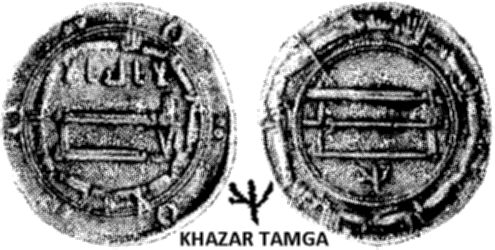 |
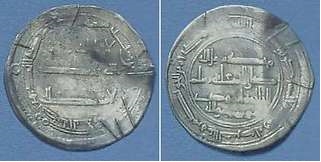 |
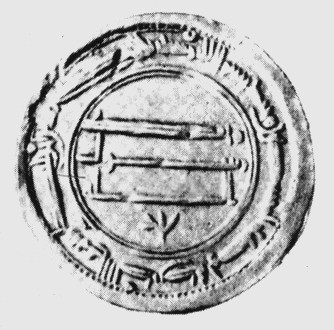 |
Khazar coin with Türkic runiform inscription
Found in Kaluga region (Central Russia) |
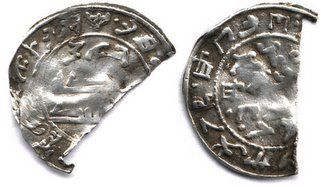 |
Türkic runes in the legend of this coin are not Orkhon or Enisei alphabet, but definitely from
Western areas (Southern Russia, Volga region, Northern Caucasus).
Attribution: Itil Bulgar or Khazar Kaganate (?), 9-10th c. (?) |
| Citation from Peter B. Golden, The Conversion Of The Khazars To Judaism//The World of the
Khazars, Leiden - Boston, 2007, p. 156 The coin legend
Musa rasul Allah “Moses is the Messenger of God”
As for the much-debated question of the dating of the conversion, we now have some
new evidence that gives added weight to al-Masudi’s notice. It has become clear that the Khazars in
the early ninth century minted coins, perhaps in response to a decline in Muslim minting in the
820s. The Khazar coins were invariably imitations of Islamic dirhams. However, they included, in
some instances, the inscription ard al-hazar (“Land of the Khazars”), Turkic tamgas
and some dirhams with the most striking formula (for imitation Islamic coins):
Musa rasul Allah “Moses is the Messenger of God,” a clear substitution for the Islamic Muhammad rasul Allah. The five “Moses dirhams”
uncovered thus far have been dated to 837/838 on the basis of die-chains.159
There can be little question that, at the
least, the governing strata of Khazaria had been Judaized by this time — perhaps relatively recently
so (as al-Masudi indicates) and wanted to dramatically and visibly assert this new religious profile
in the turbulent 830s. Coins were important ideological symbols and in the medieval “Age of Faith”
projected the official religion of the state or at least that of its ruling group.
159 R.K.
Kovalev, “What Does Historical Numismatics Suggest About the Monetary History of Khazaria in the
Ninth Century?—Question Revisited” Archivum Eurasiae Medii Aevi 13 (2003), pp. 106–114 and his “Creating
Khazar Identity through Coins: The Special Issue Dirham of 837/8” in F. Curta (ed.), East
Central and Eastern Europe in the Middle Ages (Ann Arbor, 2005), pp. 220–253.
One of the Khazar coins with legend Musa rasul Allah “Moses is the Messenger of God”
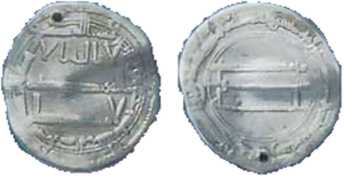
|
| Citation from Gábor Hosszú, Heritage of Scribes, 2012, p. 166 An inscribed coin was found in Sweden with Arabic and Khazar Runiform characters (Fig.
7.2.11-la, b, and c)545
Figure 7.2.11-1 a, b) The Arabic and c) Khazar Runiform inscriptions on the Bilingual Khazar Coin of
Sweden
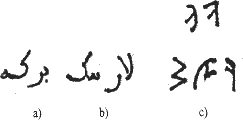
The Arabic inscription in Fig. 1.2.11-la means blessing or wealth,546 and in Fig. 7.2.11-lb a
personal name: /nâr yık/. The transcription of the Khazar inscription of Fig. 7.2.11-1c
is presented in Table 7.2.11-1.
545 Vekony 1997a
546 Charaf 2010
167
Table 7.2.11-1: Transcription of the Khazar Runiform inscriptions on the Bilingual Khazar Coin of Sweden
| Written with normalized Khazar Runiform font |
First row:
 ; second row: ; second row:
 |
|
IPA phonetic transcription |
First row: /øβy/; second row: /ik øðim/ |
|
Translation from Common Turkic (Khazar) |
First row: 'Extolling’; second row: 'Ik, myself’ |
The word /ik/ was a personal pronoun. Vekony claimed that this word is in Common Turkic (surely Khazar); since its Ogur version would be /yik/.547 However, Gombocz stated that the /yik/ in the Arabic text corresponded to the Common Turkic (Khazar) /ik/.548
The /nar/ was the name of a Kagan; see Kagan Nar
 /nar xaɣan/ the Ogur inscription of the Mayaki Amphora (Fig. 7.2.2-2). The Arabic inscription of the coin contains the full name of the
Kagan: Nar Ik in Common Turkic (Khazar). To summarize, the Arabic and the Khazar Runiform inscriptions on the coin are essentially identical. /nar xaɣan/ the Ogur inscription of the Mayaki Amphora (Fig. 7.2.2-2). The Arabic inscription of the coin contains the full name of the
Kagan: Nar Ik in Common Turkic (Khazar). To summarize, the Arabic and the Khazar Runiform inscriptions on the coin are essentially identical.
547 Vekony 2004a, p. 282
548 Gombocz 1915, p. 48; Gombocz 1908, p. 22; Gombocz 1912
|
The later coins are minted with indication of the Khazar Mint. However, none of such coins were
in the Devitsky hoard. Perhaps, this indicates that some chronological gap existed between the imitations and
the own coinage. As noted above, the description of the coins later determined as the Khazar coinage
was given still by H.M.Fren and V.G.Tiesenhausen. The latter, like H.M.Fren, included the minting places
for such coins
(without diacritics) among the unknown coins26. In 1923 R.R.Vasmer suggest
to read this word as Arz
al-Khazar, i.e. the Land of Khazars.
23 Fry R. Heritage Iran, Moscow, 1972, p. 336.
24 Lloyd S. Twin Rivers, Moscow, 1972, p. 166.
25 Bykov A.A. Ibid, p. 67.
26 Tiesenhausen VG Ibid, p. 341.
77
However, both H.M.Fren and V.G.Tiesenhausen transcribed it in a way that the “tooth” in the last
word is not perceived as an Arabic z. Consequently, without questioning reading the of R.R.Vasmer, who
sought to bring the word Khazar close to the modern pronunciation, a more legitimate is the reading
Arz al-Khasar, i.e. with interdental s (i.e. th, Arz al-Khathar).
It seems that the word Khazar in Türkic runes is written exactly with s
(th).27
Subsequently, A.A.Bykov confirmed the R.R.Vasmer's reading on with typological and paleographic
analysis. Importantly, he found that the errors in the legends and the random orientation of the
obverse and reverse dies are of he same nature as of the Devitsky hoard coins.28
In addition, the Arabic designation for the Arz al-Khazar mint is a copy of the
Khazar name. A part of the Khazar capital city Itil was called “Hazaran”,
i.e. the
Land of Khazars.
Archaism of the Khazar coin inscriptions.
A.A.Bykov emphasizes that the calligraphy of the coin inscriptions minted in Arz al-Khazar is very archaic “compared with the
Caliphate coins of 220/832 and the following years”.29 He
also notes the “undoubted
influence of handwritten script, demonstrated in arching connections between some letters in the
central legend of
the reverse, in contrast with the local Kufi style at the end of the 8th c. or the beginning of the
9th c.”30
What caused the minting of the Khazar coins with such peculiar archaic calligraphy, different from
the Caliphate
coins' calligraphy of the time? Presumably, in the coin design Khazars followed the old traditions of the Umayyads. And, in contrast to the Abbasids,
on the obverse they restrained to depiction of only one circular legend.
The stubborn persistence of the Khazars for the coins with archaic calligraphy of the religious
inscriptions from the
Umayyad time, when the orthodox form of Islam was formally adopted in the Itil region, apparently can be explained
by further intensification of disagreement between the Khazar Kaganate and the Arab
Caliphate.
Some Arz al-Khazar coins are dated by 223/837-838. A.A.Bykov notes that they “could not appear
earlier than 220s/835s and following years actually came”.31
Possibly, Khazar coins of the second half of the 9th c. do exist, but filled with violent political and ideological
clashes (Islam, Judaism, and Tengriism) in Kaganate, the Khazar minting was on the wane. After converting to
Judaism, the Khazar Kagan could only produce imitation coins. This is apparently evidenced by
ordinary coins, the imitations of the Samanid coins with beautiful inscription kanyk, i.e. Kagan's, on the bottom of the coin.
A further minting of the Kufic coins continued in another Itil area city, Bulgar, its the earliest known dated coins
date to the very beginning of the 9th c. (907-908).32
Substantially, that could be it on the Khazar coinage if not for an outstanding issue
that clearly requires explanation. That is that almost all Eastern Europe hoards of the early Kufic coins
were buried in the ground in the first quarter of the 9th c, ca 800 - 825.
27 Klyashtorny A.A. Op. cited p. 88
28 Ibid, p. 88.
29 Bykov A.A. Ibid, p. 56.
30 Ibid, p. 55.
31 Ibid, p. 67.
32 Yannina S.A. New on the coin mint of the Volga Bulgaria//MIA, Moscow, 1962. - No 111, p. 179-205.
78
Still R.R.Vasmer drew attention to that, noting that "the hoards buried in the 8th c. still
have not been found, and were found only 8th c. coins in the hoard buried in the 9th c.”1 How can
this be
explained? R.R.Vasmer was inclined to think that the coins of the earlier periods appeared in the Eastern
Europe not earlier than 800 AD.28. However, the V.L.Yanin's studies showed that single
hoards and finds of numerous individual 8th c. coins dated by 700-799 indicate that in the 8th c. they
flowed into the Eastern Europe in sufficient quantities.29 But that
observationn does not remove the posed question,
especially so because the new data cited by V.V. Kropotkin further support mass burials of the hoard in
the Eastern Europe precisely at the
beginning of the 9th c.: Petrov, 804/805; Right Bank Tsimlyan fort, 809/810 New Trinity fort, 818/819; Lower Novosel, 811/812, Kremlin 812/813; Hitrovka, 810/811.30.
For the late medieval period such event would give sufficient reasons to conclude that at that time
occurred
a monetary reform, with a prohibition of the old coins in circulation. Can be considered such a monetary reform,
unusual not only in so early a time, but also in respect of the territory coinciding with the
Slavic lands? Let us review these issues in more detail.
The souring of Khazar relations with the Abbasids in the late 8th -
early 9th c. was already stipulated above. Timewise, the beginning of the final rupture of relations
fall on the reign period of
the most powerful Caliph Harun al-Rashid ibn Mahdi (786-809) and they completely end in the 820s.,
during the reign of the Caliph Abd al-Mamun ibn Harun (813-833).
It can be seen that in that period happened a cessation of the trade routes through the Caucasus,
the importation of the Arab coins has been hampered, and possibly the Jewish advisers of the Kagan
proscribed their circulation. This insight is confirmed by the composition of the found hoards. For
example, R.R.Vasmer noted that in the hoards of the beginning of the 9th c. with the coins
minted before 820s., the African coins sometimes constitute up to 50%.31.
Accordingly, the coins of such hoards appeared still during those times when the trade routes through the Caucasus
were operational to, say, Egypt, also hostile to the Abbasids. But the hoards with coins dated by 820s
(e.g. the Uglich hoard), the African coins represent only about 6%, and even less in later hoards.32 This
attests to a turning point in trade and monetary circulation, when the coins begin to arrive to
the Eastern Europe not through the traditional trade route, the Caucasus, but through the Middle Asia,
through the Samanid state.
An image purported to be a Khazar seal with Magen Dovid star
The Türkic art employed various hexagons long before Magen Dovid was adopted as a symbol of Judaism.
The inner mechanism of these events still is not well known. But it can be presumed that obstacles to
the trade
with Egypt and other eastern countries were created by the Abbasids, and the Khazars, for their part,
could prohibit circulation of the Caliphate coins, and could try to create their own
coinage as discussed above. Thus, the monetary circulation in the Eastern Europe during the 8th and
the beginning of the 9 c. can
not be explained without admitting an active intervention of the Khazars.
33Vasmer P.P. Zavalishin hoard
of Kufic coins 7th-9th cc. -Leningrad, 1931, p. 1
34Yanin V.L., Ibid, p. 83..
35Kropotkin V.V., Ibid, p. 119.
36Vasmer P.P. Ibid, p. 12
37Ibid. p.
28
79
In the second half of the 8th c., with the rise in the Arab onslaught, the center of the
Khazar Kaganate finally moved to the banks of the Itil. Consequently, the Khazar Kagans faced
a need to establish some kind of new, more effective relationship with the Samanid state and
with the Itil region tribes. Apparently, thaty led to a clash with some of them, and resettling of other friendly tribes
in the region. The already mentioned Magyar tribes partially leave the Middle Itil and Lower Kama
areas.
Constantine Porphyrogenitus in his book “De Administrando Imperia”, talking about “ancient
location” of the Turks (Magyars) “near Khazaria”, writes that “in those days they were
not called Turks, and for some unknown reason were called Savartes-Asphals”, i.e.,
apparently belonged to the Savir-Ephtalite confederation.
|
Sabartoi asphaloi (Σάβαρτοι όίσφαλοι) The ethnic part of the compound Sabartoi asphaloi
names Suvars, whose name has numerous known allophones: Aksungur, Aksuvar, Chuvash, Sabar, Sabaroi,
Sabartoi, Sabir, Saban, Savar, Savart (still living in Azerbaijan), Severyan (Sl. annals), Sevordik
(in Armenia), Sevruks (Siberian Tatar folklore), Shüanär (endonym of Georgian Svans in Svanetia),
Sibir, Suar (Chuvash, Tatar form), Subar, Subartu, Subartuan, Suwar, Zubur, As-Savardia (Belazuri,
9th c.), Zuad (Hungarian Anonym “Gesta Hungarorum” ca 1200s, Shimon Kezai 1280s). Situation with numerous allophones was caused by the
antiquity of the term ascending to the span from the Assyrian tablets of the 23rd-20th cc. BC to the
1246 AD during Mongol conquest, and the spectrum of languages and nations Suvars encountered during
the ages. The latest attested form of the name Suvar is dated to the 1246 AD destruction of
the Suvar capital Nur-Suvar, called Sham-Suar in contemporary Tatar.
The etymology of the name Suvar is transparent: su “water, river”, ar “man,
warrior”, e.g. “River People”. The word su has allophonic forms suv (suw) and hu,
hence the allophonic names Suar, Suvar, Suwar, Huar. The form Huar was reportedly an endonym of the
Khazars, the Chazars of the “De Administrando Imperia”.
The determinant part asphaloi is a matter of various optimistic speculations: Gk.
Asphalo “free”, also “strong, firm, reliable”, also “brave”, also “unfettered”, (in modern Greek
respectively the totally phonetically unrelated dorean, ischyrí, statherí, axiópisti, gennaía, adesmefti); Arabic asphal “lower” ~ Lower Suvars, supposedly referring to the Lower Zab
river, the left tributary of the Tigers, or just the steppe Suvars as opposed to the mountain
Suvars, or just southern Suvars in respect to northern Suvars;
the Semitic asphalt “tar, petroleum” may be a most reasonable speculation, since Suvars
controlled the area of Baku that supplied this strategic material to the neighboring buyers, this
version corroborates the attested Suvar dominion. Various publications present each of these
speculations as accurate knowledge.
|
A. Mukhamadiev deduction (citation from present book, page 70): ...Asphals-Savarts of
Constantine VII are the Ephtalites-Suvars but at а first glance the form of the compound is not clear. The
trick is that in the word Ephtalite the plural ending -it was dropped (Ephtalit > Ephtal > Ethtal >
Asphal), while in the second word Suvar the plural ending -it has been added. This means that we
see a single term with the necessary plural ending at the end: Askel (Iskil)-Suvars
(a la As-Tokhars, with a single ending -lar or archaic -it > As-Tokharlar
or As-Tokharit).
The Iskils are known to be one of the tribes of the ancient Bulgars. Apparently it was a prestigious
appellation for the
tribes, in this case Suvars, with the origin ascending back to antiquity (And it is much more, with
the Chinese annals defining Iskils/Esegs/Seklers as the most potent tribe of the Huns, see Yu.Zuev
The Strongest Tribe - Ezgil).
The ancient writers, in particular Herodotus, noted that to conduct trade with the Scythians,
a merchant must have seven interpreters for seven Scythian languages. The Eskolots spoke one of these languages,
according to Herodotus their contains a meaning of royal.
Notably, the ethnonym Aces, or Ises was quite widespread in the ancient world, and at different latitudes.
Such spread of this ethnonym apparently is due to its origin coming from the notable Türkic os, us, or
uza, i.e. higher, senior in the sense of “supreme”1. The
word Eskolot after es- contains a possessive affix -k-, the word il (ail), and
the plural suffix -at. The "History”
of the Byzantine author Simocatta also gives the name of one of the Bulgar tribes in plural form
Barselt.
Thus, the word Eskolot, in our case Ephtalite (since the Hunnic alphabet has not
have a letter f, it is Iskalit),
formed according to all the rules of ancient Türkic language, can be translated as ails (tribes)
of the supreme rules, in other words, the supreme ails.
1 OTD, pp. 628, 629.
|
|
In thаt area more powerful becamе Bulgars, who resumed close trade contacts with Khorezm and
through it to other countries. They completely returned from the N.Pontic. The Iskils (Savart-Asphals), i.e.
the Imenkovs, like the Barsils, are already mentioned as Bulgar tribes. A part of Bulgars tribes settles in
the Caucasus (Balkars), and another, a part hostile to the Khazars, leaves the territory of the Kaganate and settles
by
the Danube.
With a weakening of the Imenkovs in the Kama area, for awhile are disrupted the traditional trade links with more northern
tribes, who supply the fur markets of the Itil area and the North Caucasus, which in turn had a negative
impact on the Khazar trade with the eastern countries. This is clearly seen from the coin material. If
the Kama area areas abounds with the Khorezmian, Byzantine, and Sasanid coins of the 6th - 7th cc.,
the coins hoards of the 8th - beginning of the 9th cc. are relatively rare.38
The abundance of the early Kufic coins between the Dnieper left bank and the upper course of
the Don and Itil can be explained by relocation of the fur markets and important trade routes to
these regions during the second half of the 8th c.
Apparently, these changes were associated with the political events that had been happening there at that period.
According to archaeological data, the initial Eastern Slavs were the newcomer tribes that in the 6th
c reached the interfluve of the Western Bug (Buh) and Dnieper
rivers. According to renowned archaeologist D.A.Avdusin, they began
a move up the Dnieper. That happened not earlier than the 9th c.39
The author of the “Tale of Bygone Years” informs that before resettling, the Slavs were sitting on
the Danube “and from those Slavs the Slavs scattered over the land and began to be called according
to the places where they settled”.40
In the 9th c. Slavic tribes poured from the Middle Dnieper to the more northern areas, which led
to eventual Slavization (aka Slavification, Slavify, Slavicize)
of a part of the local Finno-Ugric tribes. To the question why they have not moved to the
east, into the area later called Vladimir- Suzdal regions, the answer is clear: there their spread
was opposed by a major political alliance, which leaders, judging by the above mentioned hoards,
already at the beginning of the 9th c., at the time of the Khazar money reform, were able to conduct
large-scale operation enforcing prohibition against old coins in circulation. Was this alliance
partly Slavic of the Slavs that merged there at an earlier time?
38 Here are reviewed hoards. Finds of individual coins of that time are
also known in the area. For example,
in the burials around city Sterlitamak in Bashkortostan were found gold dinar of 705/706, silver dirhams
of 770,
774, 779. Judging by the female jewelry, this cemetery belonged to one of the Khazar subdivisions. See: Ahmerov R.B. Sterlitamak
cemetery and its study//Archaeological Monuments of the
Lower Kama region. - Kazan, 1984, p. 33.
39 Avdusin D.A., Key city//Travel to antiquity, Moscow, 1983. p. 93.
40 Stories from Primary Russian chronicle, Moscow, 1966. - p. 25.
80
Of course, it may be assumed that the coins hoards buried at the time of a pogrom, staged
sometime in the early 9th c. by the arrived from the north-west Slavic tribes, against the Baltic and Finno-Ugric settlements. But such
assumption contradicts the following very important facts. The hoards of the early 9th
c. were spreading to the more northern areas gradually, in waves. If in the core Khazar lands were
buried
hoards with younger coins dated 804-812, in the northern areas
hoards have younger coins dated 820s and
830s; hence, in the northern areas they kept circulating by inertia for some time and after the ban.
The
Khazar Kaganate was a multiethnic state. Although were built many kilometers of ramparts
with external sides aimed to the northwest against the Ruses-Normans, the Slavs also lived in the Kaganate
territory. However, in the 8th c., when the Kaganate was a powerful state, into the mentioned
areas were infiltrating not the militant Slavic tribes, whose long-term presence near the northwestern borders
is attested by the archaeological sites, but some friendly tribes that apparently were infiltrating
as isolated cases,
leaving no traces of a long-term presence in the lands they had passed through.
And the first settlements of the Slavic tribes, appearing sometime in the beginning of the 8th c.
in the Don headwaters and situated next to the Khazar forts, indicate that they were friendly
tribes. S.A. Pletneva, who studied the cremation burials in one of these settlements, found that these
were
typical burials of the Penkov culture.41 The bulk of
that culture located in the forest-steppe zone of
Ukraine and Moldova.2. We can only agree with the S.A.Pletneva's conclusions that “extremely important
is the fact of most close symbiosis of the Alan-Bulgars with the ” “Penkovians” in the new place”.42
| In her works, the renown archeologist S.A. Pletneva made numerous daring statements refuting the
self-aggrandizing myths and outright falsifications endemic to the Russian and Soviet
historiography. One of these is the above Alan-Bulgars (Алано-Болгар) concept, that makes the Alans
and Bulgars indistinguishable one from the other, as opposed to the
Scytho-Iranian theory that counterposes them. However, the “Alan-Bulgars”, studied by S.A. Pletneva in the Don headwaters, neither are Alans
nor Bulgars, the areas of the Don and Oka headwaters and Pripyat were the domains of the Suvars, the
Severyans of the Slavic chronicles, and the ethnographical traits, so daringly attributed to the
Alan-Bulgars by S.A. Pletneva, are traits of the Suvars/Severyans, with their center in
Karajar, the later called by a Slavic calque Chernihiv. Suvars were a member of the Khazar Kaganate,
but in no case they were ethnically Khazars. And their tribal confederation with a center in Karajar/Chernihiv
was in fact a powerful entity that played a major role in the histories of the Khazaria and Rus.
Subar/Sabir/Suvar/Chuvash Anabasis
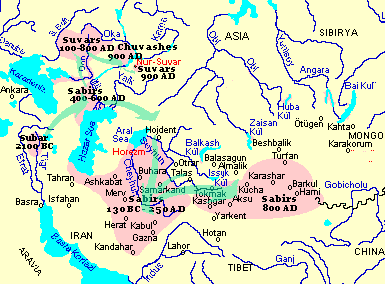
|
This study does not need to address the special problem of the Slavic expansion to the above territories.
But anyhow, already in the late 8th - early 9th
c. there formed a political alliance strong enough that with the fragmentation of the Khazar Kaganate in the second half of
the 9th c. (ca 850s) into new young state it fell entirely under the
rule of the
Eastern Slavs.
|
To confuse the Suvar Central Eastern European confederation with the “rule of the Eastern Slavs” is
uncomely. That the Suvar nation east of Itil was eventually Slavicized is beyond doubts, but their
ruling position had not diminished till the wrecking time of the Ivan the Terrible. Confusing the
lingua franca, which was increasingly that of the Slavic dependents (serfs, smerds) with the ethnic
origin of the population clouds the picture. Hopefully, this blur is a tactical move to make
contents compatible with to the official line. The fight for supremacy between the rulers in Karajar/Chernihiv
and those in Kyiv did not end till the Mongol onslaught. |
The
Khazar Kagan annually, from April, made a route (taxing and to hold court) with his court and retainers,
who mainly were Arses (?) and by the autumn returned to the capital, located in the Lower Itil. His power over vassals
in that early feudal period was quite ephemeral, or nominal. The elite of the Bulgars, Suvars, Aorses and other
tribes that constituted Kaganate endured vassal relations because Khazars retained the entire ruling
elite of the allied tribes.43
The country extended for several months of travel, and the round that lasted from a spring to autumn, could not
cover all tribes of the Kaganate. Some of them, far remote and large, became
just allies. The Chinese sources in respect of the Huns located west of them, namely Usuns and Kangars
(Usuns and Kangju), used the term “right-hand of the Huns”.
Apparently, the same “right-hand” (or allied state) were the lands of the Khazaro-Bulgars
(Bulgars of Khazaria) in the Middle Itil and the considered Slavs in the West.
41 Pletnevа S.A. Ethnical heterogeneity of population of Khazar northwestern
frontiers//New in archeology.
Collection of papers dedicated to the 70th anniversary of A.V.Artsihovsky. - Moscow, p. 114
42 Berehovets D.T. Uglich settlement on the river Tesmin/ / MIA Moscow, 1963, p. 191
43 Pletnevа S.A. Ibid, p. 115.
44 Pletnevа S.A. Khazars, Moscow, 1976, p. 57.
81
As can be seen from the mass of the hoards from early 9th c., these are the northern regions of
the Khazar
and north-eastern regions of the Slavic lands. Between Dnieper and Upper Don in the 8th
c. flourished a widely known in archeology Romeno-Borshch culture (Romen ~
Vyatka Finns, Borshch ~ Savirs). This is the earliest
territorial and political union of Slavic tribes where formed the earliest class relations.
Their settlements, like those of the Alano-Bulgars in the forest-steppe zone, were located on high river headlands,
and were fortified with ramparts and
moats. The population, along with agriculture, also engaged in blacksmithing, jewelry, pottery-making,
etc.
The history of the tribal unions of the 8th - early 9th cc. located in the above areas and far
remote from the Byzantine and
Arab world, is very weakly addressed in written sources, and is a subject of special study.
The
Arab sources preserved for us the names of some state entities of the early feudal period in the Eastern Europe,
these are Kuyaba, Slavia and Arsaniya.45 The word Arsania
or Arsalia (country of Arses) the Arabs apparently borrowed from the Khazars. In his letter,
Kagan Joseph lists Arses (Arisu) immediately after such major tribes as Bulgars
and Suvars.46 Is the appearance of this term at the Khazars
connected with the Aorses, a division of the Alans displaced by the Huns to the Don headwaters, to more
northern areas?47 The Arabic composition “Hudud al-Alam” contains
a traditional description of the Slavs' area geographical location: “This is the area to the east of which are inner Bulgars and
partly Ruses, south of it is a part of the K.r.z. sea (i.e. Khazar - A.M.) and a part of the Rum sea. To the west and north of it
lie uninhabited deserts of the north”.48
The large number of the coins hoards from the North-Eastern Rus of the early 9th c., and a discovery in the
Kriviches' area of the molds for casting imitations of the Samanid dirhams allow a closer look at this
subject.49 In
this case, contrary to the opinion of some historians who believe that besides the Kiev Rus no other
Rus existed,50 it can be opined that local name Aorses (Norman's
Roses) was reconvened to the Slavs no later than the end of the 8th
c. (800 AD), and that the “External Rus” of Constantine VII or “Arsania”
of the Arab authors
is not a fiction, but quite reliable historical fact.51
39 Zakhoder B.N. Caspian collection of information on Eastern Europe, Moscow, 1967. - V.2, p.
102.
40 Kokovtsev P.K. Jewish-Khazar Correspondence in the 10th c. - Leningrad, 1932, p. 81.
41 Shilov V.P. Aorses (historical and archaeological essay)//History and Culture of the Sarmatians.
- Saratov, 1983. -p. 34.
42 Zakhoder B.N. Caspian collection of information on Eastern Europe, Moscow, 1967. - V. 2, p.
126.
43 Vasmer P.P. On Volga Bulgaria coins in the 10th c.//IOAIE. - Issue 1. -V. 33, p. 53.
44 Artamonov M.I. History of the Khazars. - Leningrad, 1962, p. 426.
45 Shangin M.A., Vishnyakova A.F. Was there an "Outer Rus"? //Byzantine Annals. - 1958. -
V. 14, p. 97.
82




